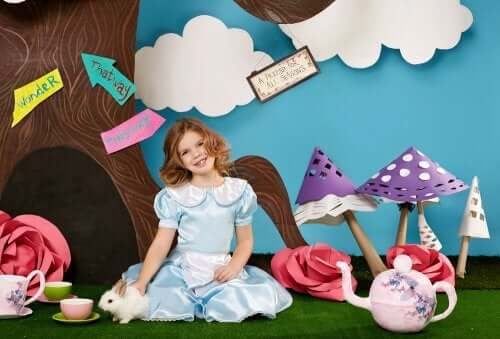8 Fun Plays for Children


Written and verified by the psychologist María Alejandra Castro Arbeláez
If you think of plays for children, certain ones may come to mind that you think they’d be great in. Theater is one of the basic activities required for learning. In addition, it has many benefits. For example, it helps children think about their individual or social problems.
Children explore the world around them by performing and doing theater. When they take on a character role or reenact a play, they use their real-world knowledge and experience to create a fantasy world.
Writing plays for children
At the beginning of each school year, many educators and drama teachers want to do a play with children. Thus, they may think about how to find plays for children that will allow them to have fun… and that the audience will enjoy!
The best advice is for teachers to become playwrights. Ideally, you should write the play you need yourself. For this purpose, you have to take into account things such as:
- The number of children in the group.
- Boy-girl ratio.
- The children’s ages.
- Each member’s previous experience in theatrical reenactments.
- Each child’s abilities and interests.
It’s necessary to adapt the play’s length and difficulty to the group.
Thus, once you know that there’s no universal database of plays for children, you can get to work. You need to start creating and writing.

However, it’s true that some well-known titles of books, movies, or stories can be adapted to a group of children. All of them will result in fun plays for children.
Things to keep in mind when writing theater scripts for children
Small children don’t know how to read yet. Therefore, it’s best to create a very short play, using something like a poem, song phrases, or a mini-story. In any case, the guiding thread will always be music.
Elementary school children have different capacities and development. For a theatrical activity, you can group children per school year by creating two subgroups:
- Children from grades one to three.
- Children from grades four to six.
For children from first to third grades, you need to write very short scripts. Therefore, the scenes will also be very short. Likewise, the text phrases should be short and the total duration of the play should be from 10-15 minutes.
Children from grades four to six can tackle more complex and lengthy theater scripts. Thus, the play can last a half-hour or even longer. Ideally, you should create many short scenes to fragment the texts and facilitate the work.
Stories you can turn into fun plays for children
Among the stories you can turn into fun plays for children, we decided to include some universal classic stories, children’s movies, and even books. Remember to create scripts specifically for each group.
Peter Pan
Children of all ages can reenact the story of Peter Pan. It’ll definitely be fun for them! Children can reenact it by using their body language. In addition, the music will be the guiding thread. Also, you can adapt the script to both elementary and high school children.
An idea you can use, if necessary, is multiple characters. In other words, you can create as many pirates (boys or girls) as you wish. The Lost Boys can be many more (or less) than those in the original story. Also, Wendy can have as many brothers or sisters as you want.
Alice in Wonderland
Alice in Wonderland is always a great story for children to reenact. This is because children tend to have a lot of fun with the story and love the characters. Since the beginning of the proposal, your students will probably know which character they want to be. However, you’ll be in charge of making the decisions, taking their preferences into account.
For example, if three children want to be the Mad Hatter, you can have three of them in the play. And, following this technique, you can adapt the original story to your group. However, don’t forget to always remain realistic about the children’s abilities to avoid frustration.

The Neverending Story
Using the book or the film as a guide, you can create an amazing Neverending Story play. If some of the children of the group know the story, it’ll be interesting to hear their versions and, based on them, create the script.
Perhaps this idea may be too complex for preschoolers, but it’s a very good choice for elementary school children. Also, you can consider it for high school children.
Other examples of stories you can turn into fun plays for children
- Labyrinth (the film that stars David Bowie).
- Lava (a Pixar animated short).
- The Jungle Book (Disney movie).
- The Lion King (Disney).
- The Little Prince (a book by Antoine de Saint-Exupéry).
Finally, you must remember that the most important thing when it comes to writing a play for children is to always keep the group in mind. Remember that not all plays can be reenacted by all groups. Also, it’s important to devote all the necessary time to doing prior exercises with them to get to know each child’s skills and interests.
If you think of plays for children, certain ones may come to mind that you think they’d be great in. Theater is one of the basic activities required for learning. In addition, it has many benefits. For example, it helps children think about their individual or social problems.
Children explore the world around them by performing and doing theater. When they take on a character role or reenact a play, they use their real-world knowledge and experience to create a fantasy world.
Writing plays for children
At the beginning of each school year, many educators and drama teachers want to do a play with children. Thus, they may think about how to find plays for children that will allow them to have fun… and that the audience will enjoy!
The best advice is for teachers to become playwrights. Ideally, you should write the play you need yourself. For this purpose, you have to take into account things such as:
- The number of children in the group.
- Boy-girl ratio.
- The children’s ages.
- Each member’s previous experience in theatrical reenactments.
- Each child’s abilities and interests.
It’s necessary to adapt the play’s length and difficulty to the group.
Thus, once you know that there’s no universal database of plays for children, you can get to work. You need to start creating and writing.

However, it’s true that some well-known titles of books, movies, or stories can be adapted to a group of children. All of them will result in fun plays for children.
Things to keep in mind when writing theater scripts for children
Small children don’t know how to read yet. Therefore, it’s best to create a very short play, using something like a poem, song phrases, or a mini-story. In any case, the guiding thread will always be music.
Elementary school children have different capacities and development. For a theatrical activity, you can group children per school year by creating two subgroups:
- Children from grades one to three.
- Children from grades four to six.
For children from first to third grades, you need to write very short scripts. Therefore, the scenes will also be very short. Likewise, the text phrases should be short and the total duration of the play should be from 10-15 minutes.
Children from grades four to six can tackle more complex and lengthy theater scripts. Thus, the play can last a half-hour or even longer. Ideally, you should create many short scenes to fragment the texts and facilitate the work.
Stories you can turn into fun plays for children
Among the stories you can turn into fun plays for children, we decided to include some universal classic stories, children’s movies, and even books. Remember to create scripts specifically for each group.
Peter Pan
Children of all ages can reenact the story of Peter Pan. It’ll definitely be fun for them! Children can reenact it by using their body language. In addition, the music will be the guiding thread. Also, you can adapt the script to both elementary and high school children.
An idea you can use, if necessary, is multiple characters. In other words, you can create as many pirates (boys or girls) as you wish. The Lost Boys can be many more (or less) than those in the original story. Also, Wendy can have as many brothers or sisters as you want.
Alice in Wonderland
Alice in Wonderland is always a great story for children to reenact. This is because children tend to have a lot of fun with the story and love the characters. Since the beginning of the proposal, your students will probably know which character they want to be. However, you’ll be in charge of making the decisions, taking their preferences into account.
For example, if three children want to be the Mad Hatter, you can have three of them in the play. And, following this technique, you can adapt the original story to your group. However, don’t forget to always remain realistic about the children’s abilities to avoid frustration.

The Neverending Story
Using the book or the film as a guide, you can create an amazing Neverending Story play. If some of the children of the group know the story, it’ll be interesting to hear their versions and, based on them, create the script.
Perhaps this idea may be too complex for preschoolers, but it’s a very good choice for elementary school children. Also, you can consider it for high school children.
Other examples of stories you can turn into fun plays for children
- Labyrinth (the film that stars David Bowie).
- Lava (a Pixar animated short).
- The Jungle Book (Disney movie).
- The Lion King (Disney).
- The Little Prince (a book by Antoine de Saint-Exupéry).
Finally, you must remember that the most important thing when it comes to writing a play for children is to always keep the group in mind. Remember that not all plays can be reenacted by all groups. Also, it’s important to devote all the necessary time to doing prior exercises with them to get to know each child’s skills and interests.
All cited sources were thoroughly reviewed by our team to ensure their quality, reliability, currency, and validity. The bibliography of this article was considered reliable and of academic or scientific accuracy.
- Daste C.; Jenger, Y. y Voluzan, J. (1978). El niño, el teatro y la escuela. Madrid: Villalar.
- Eines, J. y Mantovani, A. (1997). Didáctica de la Dramatización. Barcelona: Gedisa.
- Navarro Solano, M. (2007). Drama, creatividad y aprendizaje vivencial: algunas aportaciones del drama a la educación emocional. Cuestiones pedagógicas, 18, 163-174. https://idus.us.es/xmlui/bitstream/handle/11441/12845/file_1.pdf?sequence=1
- Núñez Cubero, L. y Romero, C. (2004). La educación emocional a través del lenguaje dramático. Addenda a la II Ponencia: Los lenguajes de las Artes. Escenas y Escenarios en Educación, XXII-Site-Sitges Conference.
- Núñez Cubero, L.; Bisquerra Alzina, R.; González Monteagudo, J. y Gutiérrez Moar, M.C. (2006). Emociones y educación: una perspectiva pedagógica. En J.M. Asensio; J. Carrasco García; L. Núñez Cubero y J. Larrosa (Coords.) La vida emocional. Las emociones y la formación de la identidad humana (171-196). Barcelona: Ariel.
- Tejerina, I. (1994). Dramatización y teatro infantil. Dimensiones psicopedagógicas y expresivas. Madrid: Siglo XXI.
This text is provided for informational purposes only and does not replace consultation with a professional. If in doubt, consult your specialist.








